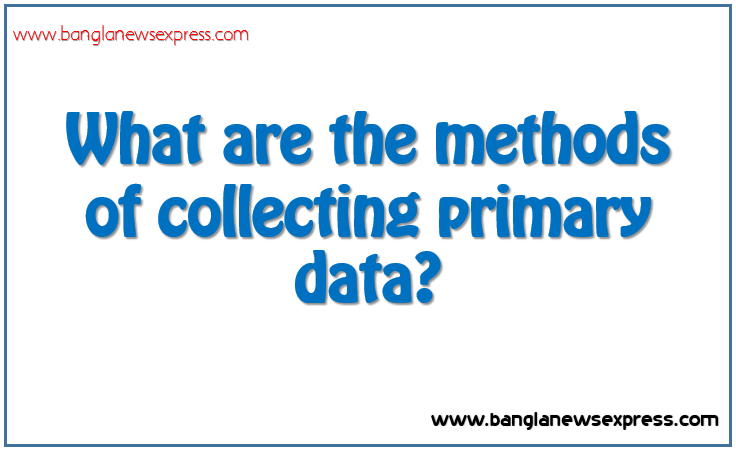What are the methods of collecting primary data?
Primary Data: Data that has been generated by the researcher himself/herself, surveys, interviews, experiments, specially designed for understanding and solving the research problem at hand.
Secondary Data: Using existing data generated by large government Institutions, healthcare facilities etc. as part of organizational record keeping. The data is then extracted from more varied datafiles.
একাডেমিক শিক্ষা বিষয়ক লিখিত প্রশ্ন সমাধান পেতে ক্লিক করুন।
Surveys:
Explanation: Surveys involve questioning individuals or groups to gather information. Surveys can be conducted through interviews (in-person or over the phone), self-administered questionnaires, or online surveys.
Points: Surveys are efficient for collecting a large amount of data from a diverse group of respondents. They can be structured (closed-ended questions) or unstructured (open-ended questions).
Interviews:
Explanation: Interviews involve direct interaction between the researcher and the respondent. This can be structured (using a predetermined set of questions) or unstructured (allowing for more open-ended responses).
Points: Interviews allow for in-depth exploration of topics, clarification of responses, and the collection of qualitative data. However, they can be time-consuming and may be influenced by the interviewer’s bias.
Observation:
Explanation: Observation involves watching and recording the behavior of individuals, events, or processes. It can be conducted in a natural setting or a controlled environment.
Points: Observation is particularly useful for studying behavior in its natural context. It minimizes the impact of self-reporting biases and can provide valuable insights into actual behaviors.
Experiments:
Explanation: Experiments involve manipulating one or more variables in a controlled environment to observe the effects. Researchers collect data on the dependent variable(s) to draw conclusions about causation.
Points: Experiments are powerful for establishing cause-and-effect relationships. However, they may not always reflect real-world conditions, and ethical considerations must be taken into account.
Focus Groups:
Explanation: Focus groups involve a small, diverse group of participants discussing a specific topic guided by a moderator. The goal is to gather insights and opinions from group interactions.
Points: Focus groups are valuable for exploring attitudes, perceptions, and group dynamics. They provide qualitative data and can uncover ideas that might not emerge in individual interviews.
Field Trials:
Explanation: Field trials involve testing products, services, or interventions in a real-world setting. Researchers collect data on the performance and user experience.
Points: Field trials provide practical insights into the effectiveness of interventions or the acceptance of products in real-world conditions. They help bridge the gap between controlled experiments and actual use.
Diaries and Logs:
Explanation: Participants maintain diaries or logs to record their activities, experiences, or thoughts over a specified period. This method is particularly useful for studying daily routines or tracking changes over time.
Points: Diaries and logs provide detailed, longitudinal data. However, they may be subject to biases if participants alter their behavior due to the act of recording.
Sensor Data:
Explanation: Sensors and electronic devices can automatically collect data on various parameters, such as temperature, movement, or physiological responses.
Points: Sensor data offer objective and real-time information. They are commonly used in scientific research, healthcare, and environmental monitoring.
When choosing a method for collecting primary data, researchers consider factors such as the nature of the research questions, the characteristics of the study population, available resources, and ethical considerations. Often, a combination of methods is used to triangulate findings and enhance the reliability and validity of the research.
একাডেমিক শিক্ষা বিষয়ক লিখিত প্রশ্ন সমাধান পেতে ক্লিক করুন।






